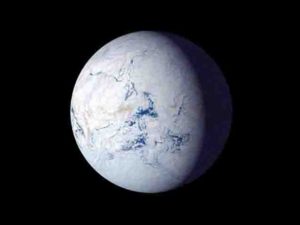
The movie The Day After Tomorrow depicts a catastrophic climate shift to global cooling, which is referred to as the new ice age. In the movie, melting of polar ice caused by global warming disrupts the North Atlantic current, rapidly dropping the ocean temperature, ultimately leading to the freezing of the ocean on a global scale. Although this over-the-top effect portrayed by this fictional film contains little scientific truth, many scientists are studying a global ice age during the Cryogenian, a geologic period that lasted from 720 to 635 million years ago.
Recent research on glacial refugia has been heating up the debate about this ice age, brewing a contention over the extent to which the glaciation covered the Earth. Two main hypotheses are on the table: “Snowball Earth” theory, which argues that ice covered the entire Earth, and “Slushball Earth” hypothesis, where the band of the sea near the equator stayed open, allowing the hydrologic cycle—the evaporation and precipitation of water— to persist.
The term Snowball Earth was first coined by Joe Kirschvink, a geobiologist at CalTech in the late 1980s. The theory was based on the early observation that glacial deposits from this time were widely distributed on nearly every continent, with some geologic evidence even suggesting glaciation at tropical latitudes. The abrupt change in the climate is rooted in the positive feedback loop, commonly referred to as the albedo (“whiteness” in Latin) effect. Simply put, as Earth cools and ice forms from the pole down to lower latitudes, the albedo, or the whiteness of the Earth increases, reflecting more solar radiation—just like how a black t-shirt absorbs more heat, while a white t-shirt reflects all wavelengths of light.
Along with the albedo effect, the long-term carbon cycle kicked into high gear, making a double positive feedback. As the ancient supercontinent Rodinia broke apart, the newly created coastline in the low latitude intensified the weathering of the rock. Silicate rock, which constitutes the majority of the Earth’s crust, goes through a chemical weathering reaction that removes CO2 from the atmosphere. As the atmospheric CO2 was reduced, Earth became colder, as CO2, along with other greenhouse gases, blocks heat from escaping the Earth. Moreover, because the broken up continents were in the low latitudes, they could not have prevented the advance of ice that formed in the poles, the coldest region on Earth, which would have created a completely frozen planet.
The critics of the Snowball Earth theory—including professor Richard Peltier and his fellow colleagues at the University of Toronto and Texas A&M—published a paper refuting the hypothesis, in which they run a series of simulations that resulted in an equatorial belt of open water that may explain the survival of the organisms during the ice age, as well as the subsequent revival of numerous species.
Their argument stems from the fact that the process of glaciation not only entailed positive feedback, but also one important negative feedback. As the climate got colder, the atmospheric oxygen would have sunk deeper into the ocean. As atmospheric oxygen spread deep into the sea, it bonded with the layer of old organic matter, forming CO2. Carbon dioxide, released back into the atmosphere, would have warmed the Earth by the greenhouse effect, which would have defrosted Earth, stopping the ice sheets and glaciers from further advancing. Therefore, such negative feedback could have prevented ice from completely covering the Earth surface.
Peltier provides another key piece of evidence against Snowball Earth theory: a geographic region that allowed the survival of fauna and flora, referred to as the “glacial refugia.” Had the Earth completely frosted itself, its harsh climate would have killed off many organisms. Moreover, complete reflection of solar radiation would have decimated photosynthetic organisms. Yet, there is no such geological indication that a mass extinction event occurred.
The debate of hard versus slushy Snowball Earth becomes more enigmatic at the end of the Cryogenic period and start of Cambrian, when the so-called “Cambrian explosion” of animal life occurs. The Cambrian explosion refers to a short interval during which many multicellular animals in diverse forms appeared on the surface of the Earth. Critics of Snowball Earth argue that such a dramatic increase in biodiversity within a short period of time would not have been able to happen in a hard Snowball Earth scenario, as many organisms prior to the explosion would have gone extinct. The supporters of Snowball Earth, on the other hand, argue that the biodiversity is simply the result of the robust micro-organisms that survived the Snowball Earth, evolving in size as well as anatomical complexity through time.
Neither of these hypotheses is set in stone, but rather are part of an ongoing debate that requires much clarification. To better understand what happened during the Cryogenian period, developing different climate models with many parameters is necessary, giving flexibility to the ever-unknown complexity of past climate conditions. Moreover, careful study of the organisms that survived Snowball Earth could further assist our understanding of this enigmatic period.
Note: The above post is reprinted from materials provided by Earth Institute, Columbia University.










